Many ancient legends tell us that in the bygone ages, a group of Seven Sages of extraordinary wisdom and untold powers visited the earth from the stars. They traveled around the world and passed on the knowledge of all the sciences and the arts to the people. They advised the kings on their royal duties, instituted the proper codes of living, and established the correct modes of ritual in order to sustain the cosmic harmony, and ensure the happiness and prosperity of the people. It was said to be a time when our planet was closely integrated with our larger cosmic family; a very different era compared to the profane world we live in today.
The most extensive accounts of the Seven Sages have been preserved in the Mesopotamian and Indian traditions, although we find traces of similar information almost everywhere. Let us begin by exploring the Mesopotamian account of the Seven Sages, where they were collectively known as the Apkallu.
The Apkallu of the Antediluvian Times
In the Mesopotamian religion, the Apkallu were Seven Sages of extraordinary wisdom who came as the teachers of humanity in the antediluvian times. The term Apkallu (Akkadian) or Abgal (Sumerian) means “sage” or “wise”. Each of the Apkallu served as a counselor of one of the seven antediluvian kings. They came from the waters of apsu, which was the “sea of freshwater” under the earth. In Mesopotamia, apsu was the term used for freshwater from underground aquifers. Lakes, rivers, springs, wells etc. were thought to draw their water from the apsu. The Apkallu were sent by the god Ea (Enki), the King of the apsu, the protector of mankind. Ea was the god of wisdom, civilization, water, fertility, crafts and magic. In the city of Eridu, Ea’s temple was called E-apsu i.e. “House of the Deep Waters”, and it was located at the edge of a swamp (an apsu).
In many texts, the Apkallu were described as “puradu-fishes”. For instance, the late Babylonian Epic of Erra, has the following lines about the Apkallu:
“Where are the seven Apkallu of the apsu, the pure puradu-fishes,
Who are perfect in lofty wisdom like Ea’s, their lord,
Who can make my body holy?” (Poem of Erra; Tablet 2, line 162)1
Figure 1: Drawing from an ancient bas relief depicting a fish-skin cloaked Apkallu from Nimrud, Iraq, 859 – 883 BC. (PD0)
The description of the Apkallu as puradu-fishes has been an enduring mystery. Many Assyrian relief carvings of the Apkallu show them as a man wearing a fish-skin cloak. The first of the Seven Sages who had appeared in Babylon in the antediluvian times was called Uanna (Akkadian) or Oannes (Greek) and he had the title Adapa meaning “wise”. The Chaldean astrologer Berossus – a contemporary of Alexander and a priest at the temple of Bel – wrote about Oannes in the Babyloniaca (c.300 BC). Berossus said that in the ancient times there was a great crowd of men at Babylon, and they lived without laws. In the first year of the reign of Alulim, the first antediluvian king of the Sumerian King List:
“There made its appearance, from a part of the Erythraean Sea which bordered upon Babylonia, an animal endowed with reason, who was called Oannes. The whole body of the animal was like that of a fish; and had under a fish’s head another head, and also feet below, similar to those of a man, subjoined to the fish’s tail. His voice too, and language, was articulate and human; and a representation of him is preserved even to this day.
This being in the day-time used to converse with men; but took no food at that season; and he gave them an insight into letters and sciences, and every kind of art. He taught them to construct houses, to found temples, to compile laws, and explained to them the principles of geometrical knowledge. He made them distinguish the seeds of the earth, and shewed them how to collect fruits; in short, he instructed them in everything which could tend to soften manners and humanize mankind. From that time, so universal were his instructions, nothing material has been added by way of improvement. When the sun set, it was the custom of this being to plunge again into the sea, and abide all night in the deep; for he was amphibious. After this there appeared other animals like Oannes, of which Berossus promises to give an account when he comes to the history of the kings.”2
Accounts such as these really make one wonder how much we really know about our planet and our past. Not only was Oannes possessed of unearthly wisdom, which he imparted to the Babylonians in the antediluvian times, but he was a fish-man and dived under the sea at night. Did he, and the other Apkallu, truly come from a subterranean world located in the midst of the underground aquifers (apsu), which could, perhaps, be accessed by passages under the sea?
The Subterranean Kingdom of the Serpents
There are so many legends from around the world which speak of a subterranean land peopled by spirits and supernatural beings. A number of Native American tribes such as the Hopi, Navajo, Iroquois, and Mandan Sioux believe that their ancestors emerged from a subterranean land, through caverns and tunnels.3 Every time the Hopi Supreme Creator Sotuknang destroyed the world, some of the righteous Hopi were taken to safe locations in the subterranean world.4 In Irish legends, the underworld Annwyn was populated with fairies and demons, spirits and deities, and could be reached through portals hidden inside mounds or tumuli.5 The Greeks built sanctuaries in caves, for they believed that certain caves had passages that led to the underworld.6 The Mayans also regarded caves and cenotes as openings to their watery underworld of nine subterranean levels.
In Indian legends, there are seven subterranean regions which are collectively called Patala or Naga-loka. These are the realms of the divine serpent beings called Nagas – and other spirit beings called Daityas, Danavas, and Yakshas – all of whom are progenies of the Seven Sages of Vedic tradition. The Nagas are generally depicted in a part human – part serpent form, sometimes with a seven-hooded serpent canopy over their head, guarding the entrances to Hindu temples. They are believed to be wise and powerful and act as the guardians of treasures and sacred teachings. The Nagas are still worshipped in villages across India on a specific day of the year (Naga Panchami) for fertility, virility, and protection against snakebites. The subterranean regions where the Nagas dwell are said to be delightful, filled with resplendent palaces ornamented with precious gems, groves, lakes and rivers.7 The sun and moon cannot be seen there, but the jewels decorating the hoods and body of the Nagas emit an effulgence that illuminates the region.8
In Southeast Asia, the indigenous people believe that the Nagas are the benefactors and protectors of humanity. They are capable of changing their forms, and Naga princesses are said to have married human kings in the past. They assisted people in establishing cities, digging irrigation channels, and protecting dams. But if the kings or the subjects become wicked, the Nagas punish people by releasing excess water which causes disastrous floods that wipe away villages.9 As per Thai and Laotian beliefs, the serpent lives in a subterranean watery kingdom called Muang Badan, which is the endless water source that keeps the Mekong River and all rivers of the world from drying out.10

Figure 2: Many Hindu-Buddhist Temples have Nagas depicted at their entrances, functioning as protectors of the sacred realm. Link1, Link2.
It may not be very well-known that, during the Roman times, Osiris (whom the Romans called Serapis), the Lord of the Underworld in ancient Egypt, and his consort Isis, were depicted by the Greco-Roman sculptors as part or full serpents, resembling the Naga serpents of Asia. This is really strange. Why did the Romans adopt this artistic convention?
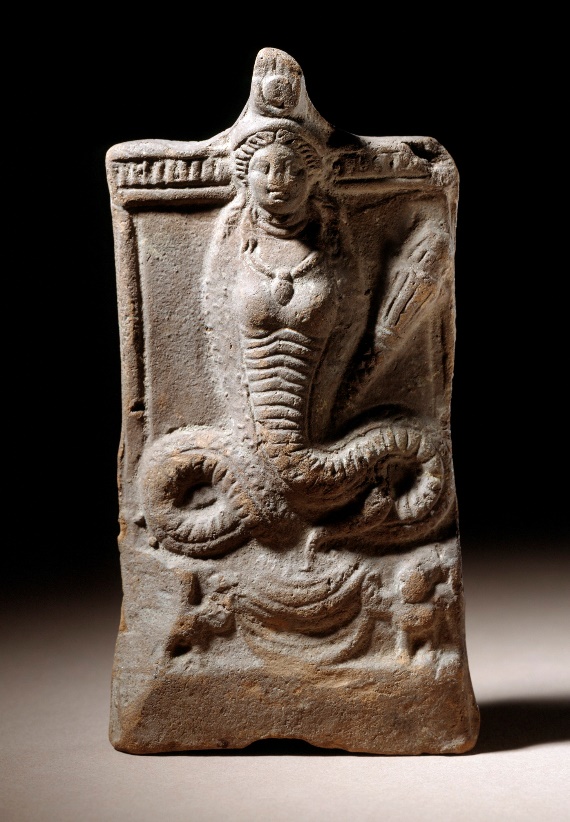
Figure 3: The Romans depicted Isis with a serpent tail. Egypt, Terracotta, 2nd century AD. (PD0)
It is generally believed that Serapis was a syncretic deity, derived from the worship of Osiris and his sacred bull Apis, who were together known as Userhapi. Interestingly, a temple of Sarapis existed in Babylon, and the deity of this temple was consulted when Alexander was on his death bed.11 In the Babylonian context, it was the god Ea (Enki) who was called Sar Apsi, meaning “King of the Apsu”. It is possible, that the Romans took the term Serapis from Sar Apsi, the title of Ea, who ruled in the apsu and sent the Apkallu to Babylon in the antediluvian times.
So, the question is, did Ea have any serpentine attribute? Although the cylinder seal representations of Ea does not reveal any snake-like feature, one of the Sumerian epithets of Ea was ushumgal, which means the “great serpent”.12 This opens up the possibility of a serpent aspect in Ea, although the term “great serpent” could also be a metaphor for a man of “great wisdom”, for Ea was the wisest of the Mesopotamian gods. Things become more interesting, though, when we consider Nergal – the god of war, destruction and pestilence – who was the Lord of the Apsu or Underworld in the Akkadian times (c.2000 BC). Nergal was depicted with serpent heads sprouting from his shoulders, waistband, battle-axe, feet – which clearly establishes his serpent nature. One of his titles was “Tamer of Serpents”13, which can be interpreted as “Lord of Serpents.” Nergal’s son (or grandson) Ningishzida also had serpent heads emerging from his shoulders. Sometimes, he was represented as a serpent with a human head and by the symbol of a pair of serpents coiled around a staff. This is the same symbol that the Greeks call the caduceus, which was carried by Hermes, the messenger of the gods. One can find this symbol carved in stone, scattered across India, in all those places where Nagas used to be worshipped.

Figure 4: Nergal, the Akkadian Lord of the Underworld, and his grandson Ningishzida, were depicted with serpent symbolisms. Link1, Link2
Thus, we have a whole family of Mesopotamian deities of the underworld – sometimes collectively referred to as the Annunaki – who have very obvious serpent associations. This connects them to the Nagas of Asia, who are said to rule in the subterranean watery realms. Are we to dismiss this worldwide body of legends and symbols as mere fantasies, or should we subject them to serious scrutiny before formulating any particular opinion?
Under our feet, there are vast reservoirs of freshwater, which extend up to 30,000 feet below the surface. Nearly 30% of the total freshwater of our planet is contained in these aquifers (the vast majority of the remaining being locked up in glaciers). The subterranean aquifers have many vertical levels separated by layers of porous rock, similar to the multiple levels of the underworld that the ancients spoke about. The tiered watery underworld of myths does, in fact, exist! The underground aquifers supply fresh water for the springs, rivers, lakes and other surface waterbodies – which is exactly what the ancients believed as well. And yet, how much do we really know about the ecosystem of these aquifers? Very little, for they are practically unexplored.

Figure 5: Multiple levels of underground aquifers, separated by confining beds of rock. Source: USGS (PD0)
Is it not possible that, in the midst of these aquifers, there are islands of green, where unknown life forms thrive? Cracks and caverns on the surface of the earth could act as conduits for air and refracted sunlight into these dark regions, creating a perpetually pleasant environment that is protected from the extremes of temperatures. The subterranean realm may be accessible through tunnels and vents located under mountains, lakes, rivers and seas, which are camouflaged and guarded to prevent unwanted intruders. As per Sumerian legends, the underworld has seven gates which are guarded by a gatekeeper called Neti.
Perhaps, the denizens of this otherworldly realm are bioluminescent i.e. they spontaneously emit light due to a chemical reaction in their body. This would explain the so-called “jewels of the Naga” that illuminates the netherworld. Bioluminescence is found in many deep sea fishes and other marine organisms like jellyfish, algae, bacteria etc., who emit light from their bodies that make the seas glow and glitter. This occurs due to the presence of a light-emitting molecule called luciferin, which produces light when it reacts with oxygen. Many organisms also produce the catalyst luciferase, which helps to speed up the reaction.
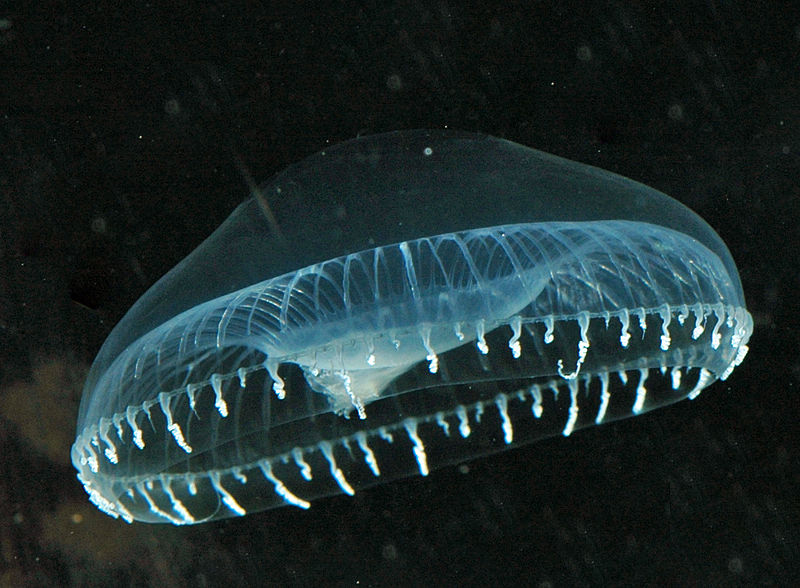
Figure 6: The bioluminescent jellyfish Aequorea Victoria. Source: Wikimedia Commons / Sierra Blakely.
Is it not possible that an advanced race of beings have made these subterranean aquifers into their habitat, and they choose to reveal themselves to us only in certain epochs when the consciousness of humanity is elevated enough to imbibe their wisdom?
The subterranean geography of our planet includes many rivers which flow underground. Some of them flow partly underground, disappearing into a sinkhole only to reappear further downstream. These underground rivers may have formed lakes and valleys and carved out caves, gorges and canyons, of which we know nothing about. Let me relate a story from the Mahabharata here. Once the prince Bhima was poisoned by his envious half-brothers, who tied him up and threw him into the River Ganges. The water currents swept him along a mystical path to the realm of the divine Naga serpents. There, Bhima was recognized by the Naga king Vasuki, who revived him and offered him a celestial ambrosia to drink which would confer on Bhima enormous strength. Having consumed the divine elixir, and feeling rested and rejuvenated, Bhima took a bath in the sacred waters of a subterranean river and purified himself. Subsequently, the Nagas led him from this subterranean region to the River Ganges, and he emerged at the very place from where he had been pushed in.14
Considering that we know practically nothing about the ecosystem of the aquifers that extend up to 30,000 feet below the earth’s surface, or of the subterranean geography of our planet, it is premature for us to dismiss stories such as these as nothing more than fairytales. Things may not have been the same way on our planet all the time; the past may have been radically different from the present, as all the ancient legends tell us. We need to keep an open mind and let the ancients speak for themselves, so that we may be able to comprehend the truth of what they were trying to tell us.
The Plans of Heaven and Earth
Let us come back to the topic of the Apkallu. Specific information about the names of the Apkallu and their attributes were discovered in a ritual incantation on the Bit meseri tablet series. These incantations were used during the performance of apotropaic rituals to counter evil portents. For the rituals, the Sumerians used to make seven clay figurines of the Apkallu, and after the ritual was completed the figurines were buried under the floor, to avert evil from the buildings and sickness from the inhabitants. In one of the Bit meseri incantations, the Apkallu are referred to as the “pure puradu-fishes” who “originated in the river”, and they are collectively extolled for their ability to “control the plans of heaven and earth”.
“U-Anna, who accomplishes the plans of heaven and earth, U-Anne-dugga, who is endowed with a comprehensive understanding, Enmedugga, for whom a good destiny has been decreed, Enmegalamma, who was born in a house, Enmebulugga, who grew up in pasture land, An-Enlilda, the conjurer of the city of Eridu, Utuabzu, who ascended to heaven, the pure puradu-fishes, the puradu-fishes of the sea, the seven of them, the Seven Sages, who have originated in the river, who control the plans of heaven and earth.”15
The Apkallu were great builders, as is evident from the epithet of An-Enlilda, “the conjurer of the city of Eridu”. The Seven Sages were associated with the founding of the seven ancient cities of Sumer: Eridu, Ur, Nippur, Kullab, Kesh, Lagash and Shuruppak. As per the Epic of Gilgamesh, the Seven Sages had laid out the plan of Uruk.
After the Deluge, however, mortal men of learning took over the duties of the Apkallu. In some texts, the post-Flood sages are referred to as Ummanu (meaning “craftsmen”) in order to distinguish them from the Apkallu. The Epic of Erra tells us that, after the Flood, the storm god Marduk had banished the Apkallu to the apsu. Subsequently, earthly Ummanus were given the task of cleansing Marduk’s shrine.16
The Iconography of the Apkallu
The most striking aspect of the Apkallu is the manner in which they were depicted on the Assyrian seals and in Assyrian art. Some of them look like a man dressed in a fish-skin cloak, which is how the first Apkallu Oannes was described by Berossus. Some are human looking; they are probably the earthly Ummanus of the post-Flood period. A few, quite mysteriously, are depicted as bird-men, having the face of an eagle but body of a human. Perhaps, the bird-headed Apkallu were capable of flight? The Apkallu Utuabzu “who ascended to heaven” could have been one of them.

>Figure 7: The Apkallu or Seven Sages of Mesopotamia were depicted in the form of a fish-man, winged bird-man or a winged human. Link1, Link2, Link3
Generally, the Apkallu are crowned with a horned helmet, which was a symbol of divinity in ancient Mesopotamia. In most cases, they have four wings, of which two or three are visible in profile. They wear rosette bracelets or prayer beads on their wrists.
I came across an interesting article17 in the Ancient History Encyclopedia written by Osama Shukir Muhammed Amin, which explored in detail what the Apkallu hold in their hands. This helps us to understand the ritual significance of these objects and to find connections with similar artifacts in other cultures. Many Apkallu figures carry an object in their left hand that has been popularly described as a “hand bag”, but it is actually a ritual bucket containing sacred water (called banduddu in Akkadian). The Apkallu sprinkle this holy water using a pine cone (called mullilu in Akkadian) that they hold in the right hand. This is an act of ritual purification using holy water that still persists in many religions today, including Christianity, Buddhism and Hinduism.

Figure 8: The Apkallu hold a ritual bucket containing sacred water (banduddu) in their left hand and a pine cone (mullilu) in their right hand for sprinkling the sacred water. Link1, Link2
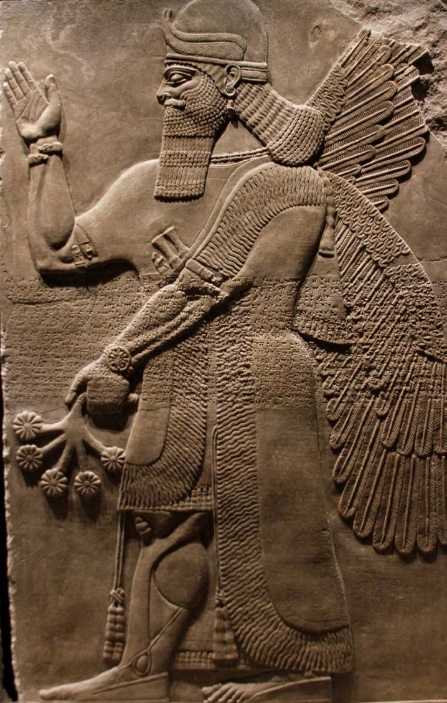
Figure 9: Human Apkallu with his right hand raised, and holding a flower bunch in his left hand. Source: Wikimedia Commons / José Luiz Bernardes Ribeiro CC BY-SA 4.0. Link
Apart from the ritual bucket, the Apkallu may hold in their left hand a prayer bead (rosary), a flowering bunch or a scepter. In all such cases, the right hand is empty and raised up such that the palm faces the viewer. In Indian art, this hand position is called the abhaya-mudra i.e. the fear-dispelling hand posture. These objects held by the Apkallu reveal their many functions as sages and royal priests of the kings. Not only were they teachers of mankind, but they also performed many ritual functions, and were looked upon as figures of authority who afforded protection to the people.
The Ritual Bucket in Sacred Art
It is interesting how the objects associated with the Apkallu can be seen in widely dispersed cultures, as has already been noted by many researchers. The ritual bucket containing sacred water (banduddu) can be seen in an Olmec carving from c.900 BC (Stella 19 at La Venta) which depicts a god or a priest, seated in the coils of a serpent (possibly the Feathered Serpent), holding a bucket in one hand, which looks exactly like the banduddu. In the Mythic Image, Joseph Campbell noted that “the left hand of this seated figure is held somewhat awkwardly (as remarked by the archaeologists-discoverers, “turned at the wrist with the palm out”), in a gesture that in the Orient would be everywhere interpreted as the “boon-bestowing hand posture” or varada-mudra of a divinity.”18

Figure 10: La Venta Stela 19, depicting a deity or priest seated in the coils of a Feathered Serpent. In his right hand he is holding the banduddu, and his left hand is in the varada-mudra posture. Source: Wikimedia Commons / Audrey and George Delange CC BY-SA. Link
Thus, the Apkallu are depicted performing the abhaya-mudra (fear-dispelling hand posture) with the right hand, while the Olmec deity or priest is performing the varada-mudra (boon-bestowing hand posture) with his left hand. Incidentally, these two mudras are often performed together. Many depictions of the Buddha show him performing the abhaya-mudra with the right hand and the varada-mudra with the left hand. It’s as if there was an unwritten rule specifying which hand should be used for performing which mudra and cultures around the world stuck to these conventions.
It has been noted by researchers that the ritual bucket motif appears on a monolithic T-shaped pillar at the archaeological site of Gobekli Tepe in Turkey, where the oldest layer of the site has been dated to c.9000 BC – a few centuries after the end of the last Ice Age. In the excavation pits on top of a hill, archaeologists have found many T-shaped pillars arranged in circles. The tallest pillars tower 16 feet and weigh between seven and ten tons. Some are blank, while others are carved with animal motifs: foxes, lions, boars, scorpions and vultures. Archaeologist Klaus Schmidt who excavated the site described these circular stone rings as the “first human-built holy place”, and humanity’s first “cathedral on a hill”.19
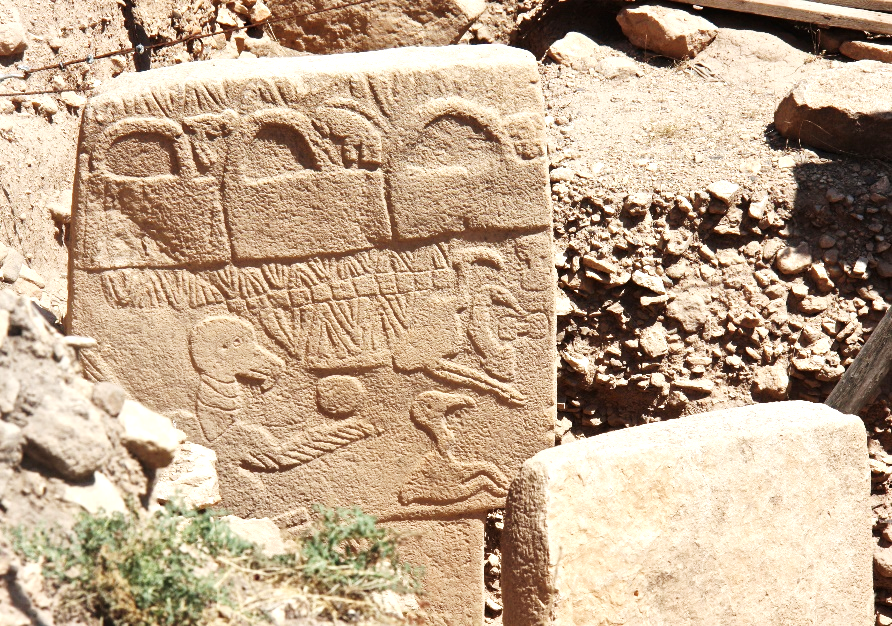
Figure 11: A row of ritual buckets (banduddu) depicted on Pillar 43 in Enclosure D, also known as the Vulture Stone of Gobekli Tepe, Turkey. Source: Wikimedia Commons / Sue Fleckney CC BY-SA 2.0. Link
On one of the T-shaped pillars on the circumference of a ring of stones, a row of buckets has been carved in relief, resembling the banduddu held by the Apkallu. Just below that, is the carving of a vulture holding a circular object, which could be that of an eagle-headed Apkallu sprinkling sacred water using a pine cone (mullilu), in order to make the lands pure and fertile. The implications of this are tantalizing: at around 9000 BC, the people who built Gobekli Tepe knew about the Seven Sages, and probably saw them, as they went about performing purification rituals for the fertility of the land. Since Gobekli Tepe was built a few centuries after the end of the Ice Age, when the melting ice precipitated a global flood which is recounted in the flood legends of many cultures, it is quite possible that the knowledge of the Apkallu extended into the antediluvian times, which is exactly what the Sumerian legends tell us!
The Apkallu in Africa and Australia?
The Dogon tribe of Mali in West Africa also appear to have retained memories of their interaction with the Apkallu. As per their beliefs, thousands of years ago they were visited by amphibious, fish-men called the Nommo, who came from the Sirius star system and taught the Dogon many skills. Like the Sumerian Apkallu, the Nommo were depicted with a humanoid upper torso and a fish-like lower body. They descended from the sky in a vessel accompanied by fire and thunder. After arriving on our planet, the Nommo dug a reservoir of water and dived into it, since they needed a watery environment to live in. They are referred to by the Dogons as their “Teachers”, and the “Masters of Water”.
The Dogon legends relate that the sky-god Amma had created four pairs of Nommo twins at the very beginning of creation. One of them had rebelled against the universal order of Amma, because of which one of the Nommo progenies was sacrificed by Amma, leaving seven of them. In the book, The Sirius Mystery (1976), Robert Temple wrote that the Dogons knew that Sirius was a binary star, consisting of the bright star that we see called Sirius A, and a white dwarf star called Sirius B, which is invisible to the naked eye. The Dogons also knew that Sirius B revolves around Sirius A in an elliptical orbit, once in 50 years. This anomalous knowledge of the Dogons has been a source of great mystery since Sirius was identified as a binary system by modern astronomers only in 1862.
It appears that the Apkallu had visited the Aboriginal Australians as well, in their global mission of propagating the laws of civilization. The inhabitants of the Kimberley region of north-west Australia speak of powerful Spirit Beings called Wandjinas, who came down from the Milky Way and brought the law, culture, and language of their people. Wandjina images can be seen painted on the rock galleries throughout the region, marked in red and white ochre. The paintings were traditionally repainted each decade to ensure the image was kept fresh and lively. It is estimated that the earliest layers of the paintings may date back nearly 4,000 years. The Wandjinas are typically depicted with a large white face, round black eyes, a nose, but without any mouth. They have a red halo around the head, with rays of light radiating outwards.
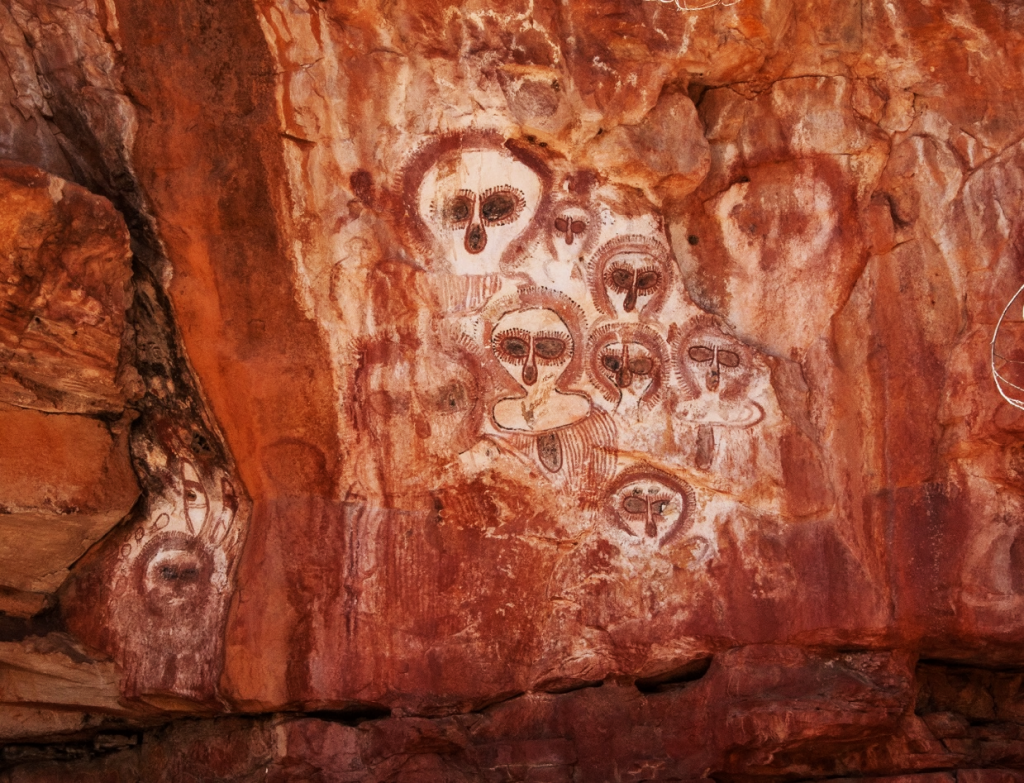
Figure 12: Wandjina Rock Art on the Barnett River in the Kimberley region of Western Australia. Source: Wikimedia Commons / Graeme Churchward CC BY 2.0. Link
As per the Dreamtime stories of the Mowanjum community, the first Wandjina was called Idjair. He lives in the Milky Way and is the father of all Wandjinas. The Wandjina Wallungunder was Idjair’s first son and he created the Earth and all life upon it. After that he created the first human beings, the Gyorn Gyorn people. Wallungunder travelled back to Idjair to bring back more Wandjinas to give the Gyorn Gyorn people laws to live by.20
The Wandjinas taught the Aboriginals everything thy needed to know, and after their work was done, they painted their images on the cave walls and entered a nearby water hole. Since then, they have lived at the bottom of the water source associated with the rock paintings. They are regarded as powerful Rain Maker spirits, who control the clouds and rainfall and punish those who break the laws with floods, lightning and cyclones.
There are some obvious connections between the Apkallu and the Wandjinas, which suggest that they are one and the same. Like the Apkallu, the Wandjinas gave the Aboriginals their laws, culture and language, and, just as the Apkallu came from the freshwater aquifers under the earth, the Wandjina entered the watering holes and returned to the bottom of the water source associated with the cave painting sites. In some respects, however, the powers of the Apkallu seems to exceed that of the Apkallu, for they were said to have come from the stars of the Milky Way, and they created the earth and all living beings. As we shall see later, the Seven Sages of Vedic India were also believed to be of extraterrestrial origin. They were “luminous beings of light” (which would explain the rays of light coming out of the halo around the Wandjinas head) and were ascribed with similar, extraordinary powers of creation.
The Seven Sages of Greece
Even though the Seven Sages are not mentioned in the ancient legends of Greece, around the 6th – 7th century BC seven of the wisest philosophers, statesmen and lawgivers of Greece were designated as the Seven Sages. Very likely, this was a continuation of an earlier tradition, the origins of which are lost in the mists of history. The earliest list of the Seven Sages, mentioned in Plato’s Protagoras (c. 387 BC), includes Thales, Pittacus, Bias, Solon, Cleobolus, Myson, and Chilon.21 An important name to note in this list is that of the Athenian lawgiver Solon, who had brought back the legend of Atlantis from Egypt. The Seven Sages of Greece were known for their wisdom in all areas of knowledge, from poetry and politics to predicting eclipses. Many of the maxims that appear at Delphi are attributed to the Seven Sages, such as: Meden Agan (“Nothing In Excess”) and Gnothi Sauton (“Know Thyself”).
The Saptarsis of Ancient India
Outside of Mesopotamia, the most extensive mention of the Seven Sages are found in India. The Vedic tradition talks of Seven Sages of divine origin – “luminous beings of light” – who were the “mind born sons of Brahma”. These Seven Rsis were collectively known as the Saptarsis (Sapta = Seven; Rsis = Sages). In the Epics and the Puranas, they are generally enumerated as: Marici, Atri, Angiras, Pulastya, Pulaha, Kratu and Vasistha. The divine Saptarsis took human wives, and established Rsi lineages. Some of their descendants became illumined sages, who “attained heaven” through the performance of sacrifices and took over the mantle of Saptarsis from their predecessors. This led to the formulation of a new list of Seven Sages: Vishwamitra, Jamadagni, Bharadvaja, Gautama, Atri, Vasistha and Kashyapa, with Agastya added as the eight sage in some contexts. The Vedic convention, thus, mirrors that of Mesopotamia, where the seven antediluvian Apkallus of divine origin were followed by earthly Ummanus in the post-Flood period.
Although the second list of Saptarsis (starting with Vishwamitra) were of earthly origin, they became more famous than their divine ancestors. This is because, they came to be regarded as the founders of the seven main gotras i.e. clans or ancestral lineages of the Hindu. Originally, only the people of the priestly or Brahmin class traced their ancestry to one of the Seven Rsis. Later, all classes were included. In the Sutra texts22, it is laid down that the Kshatriya (warrior class) and the Vaishya (business class) should take the gotra of their Purohita i.e. family priest. Today, every Hindu has a gotra, by which they claim descent from one of the Seven Sages. One cannot marry someone from the same gotra. Thus, the gotra organization ensures a form of clan exogamy, which was prevalent in many ancient societies. The ancients knew very well that exogamy (outbreeding) reduces the risk of children having genetic defects – something that scientists have discovered in recent times.
As early as the Rig Veda, hymns were sung in adoration of the Seven Sages: “They who were versed in ritual and metre, in hymns and rules, were the Seven Godlike Rsis.”23 They were the “Seven Holy Singers”24, the “Gods of Old”25, and “Our Fathers” who first performed this sacrificial worship.26 In a Rig Vedic hymn to Vasistha, he is called the “knower both of earth and heaven”27, an epithet also used for the Sumerian Apkallu.
In the book The Traditions of the Seven Rsis28, Dr. John Mitchiner explored in detail what the ancient Sanskrit texts tell us about the Saptarsis. In nearly all contexts, they are described as the “mind born sons of Brahma” (manasputra), where Brahma is the Universal Soul who pervades all of creation. In the Bhagavad Gita, when Lord Krishna reveals his universal form to Arjuna, he says: “The seven great sages and the four ancient ancestors were born from my mind and received my power. From them came all the creatures of this world.”29 The Saptarsis have been termed as the Prajapatis (“Lords of Creation”), Vipra (“sage”), and Brahmarsi i.e. a sage who has acquired the highest spiritual knowledge or “Brahma-jnana”, and thereby attained moksha.
The Seven Rsis are luminous beings of light, “the Seven Bright-Crested Ones: by their unanimous opinion there came into being what is called the supreme sastra (sacred scriptures)”30, from which “the dharma of the entire working of the world springs forth.”31 They were the “foremost knowers of the Veda, who were created as teachers of the Veda.”32 “Spontaneously attaining wisdom, they are established in dharma”33. They are “knowers of yoga” and “teachers of the science of moksha (liberation)”34. Sanat Kumara described them as the “seven unassailable brothers whose vamsas (lines of descendants) are celebrated…they sustain these three worlds, and are honored by gods and demons.”35 Vrdhha Garga said that the Seven Rsis are devoted to dharma and intent upon the protection of living beings. The epic tradition indicates that the Saptarsis were the teachers and priests of Iksvaku, the first king of the solar dynasty, and his contemporaries and successors.
In essence, the Seven Rsis are regarded as luminous celestial beings, the repository of all Vedic wisdom. They fully comprehend the inner dynamics of the universe – how all things are interconnected and interdependent – and they come to the earth periodically as teachers of humanity to ensure that living being acts in accordance with the cosmic laws. The codes of living that they enjoin and the rituals that they establish works for the greater good. In addition to composing Vedic hymns, the Rsis have also been credited with authoring works in myriad disciplines such as yoga, medicine, astrology, weaponry, architecture, music, language, grammar etc. It is believed that after accomplishing their work on earth, the Saptarsis depart to their heavenly abode called Maharloka, which is one of the five heavens above the earth (Bhur) and its atmosphere (Bhuvar).
Different texts provide us with bits and pieces of information regarding how often the Saptarsis appear on earth to promulgate the Vedic wisdom. As per the Matsya Purana, the Saptarsis appear in every Satya Yuga (Golden Age) to instruct the people in dharma.36 A passage in the Vayu Purana and Brahmanda Purana adds that, at the start of every Treta Yuga (Silver Age) the Saptarsis, together with Manu, re-establish dharma and people the worlds through the Rsi-vamsas (Rsi lineages).37 This information correlates with the flood legend in the Mahabharata in which Manu is accompanied by the Seven Sages in the ship that takes them to safety. Another passage in the Matsya Purana states that the Saptarsis took birth in the Dwapara Yuga (Bronze Age), wherein they conquered death and gained immortality.38 This must be referring to the earthly descendants of the divine Saptarsis, who had to perform sacrifices and penances to attain liberation. A passage in the Vishnu Purana tells us that the Saptarsis come to the earth after every Cycle of four Yugas i.e. after the end of the Kali Yuga (Iron Age) in order to teach the Vedas again.39
When we put together all of this information, a more comprehensive picture begins to emerge about the periodic involvement of the Seven Rsis in our civilization. It appears that the Saptarsis come to the earth in the Satya Yuga (Golden Age) and stay on for some time in the Treta Yuga (Silver Age) when they re-promulgate the Vedas and establish lineages. Their human descendants carry on the tradition till the end of the Dwapara Yuga (Bronze Age). During the Kali Yuga (Iron Age), which is the present age of darkness, strife and violence, the Saptarsis are seen no more, and the Vedic wisdom and Rishi lineage is gradually lost. The Saptarsis return to the earth once again after the end of the Kali Yuga to establish dharma and re-promulgate the Vedas.
The Iconography of the Saptarsis
Not many architectural depictions of the Saptarsis as a group are to be found in India. However, a number of sculptures and relief carvings of the sage Agastya have survived, especially in the temples of South-east Asia. Agastya was regarded as one of the Saptarsis (of earthly origin), who had led a migration from Dvaraka to the south, and as such was highly venerated in Southern India, and subsequently in Southeast Asia when Tamil influence reached there.
Most sculptures of Agastya show him holding a kamandalu or water pot (containing sacred water used for ritual purification) in the left hand, and a prayer bead in the right hand. The sacred water pot in Indian iconography looks different from the ritual bucket (banduddu) of Mesopotamia, but serves the same purpose. In some carvings, Agastya’s right hand is in the gyan-mudra posture (bestowing wisdom), and he holds a flower in his left hand. Occasionally, a trisula (trident), is depicted behind him.
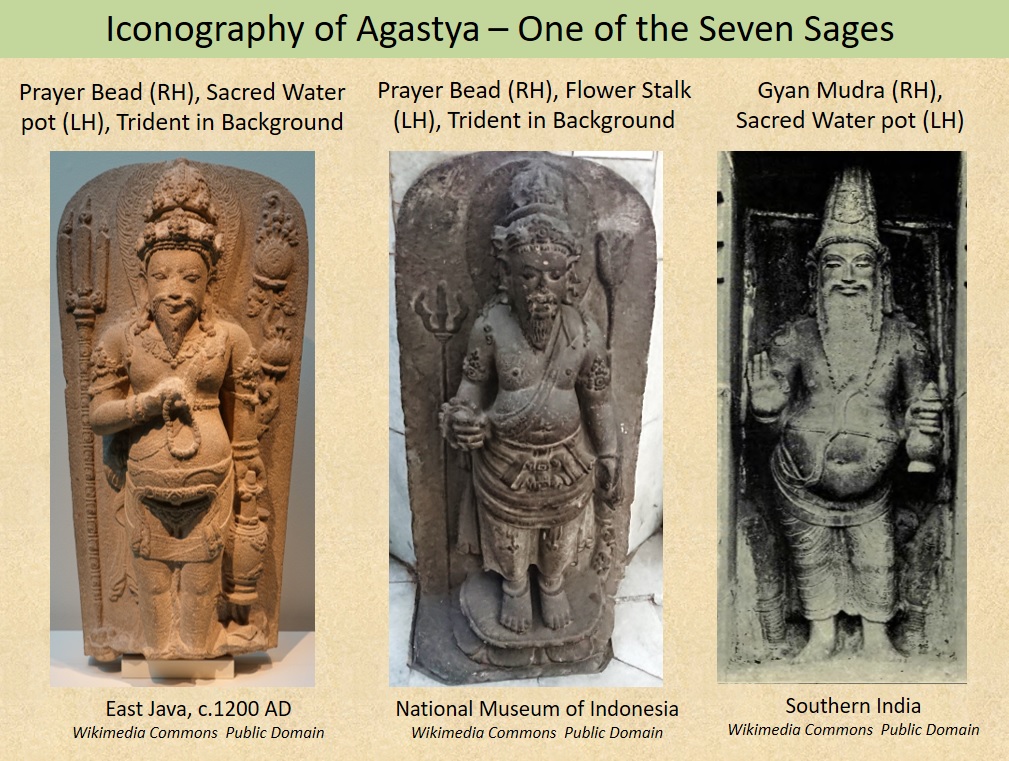
Figure 13: The iconography of the sage Agastya, who is regarded as one of the Seven Sages of the Vedic tradition. Link1, Link2, Link3
Thus, a number of iconographical elements associated with Agastya (and, by extension, the Saptarsis) overlap with those of the Sumerian Apkallu, such as the sacred water pot, prayer bead, flower, mudra position of the hand (abhaya mudra / gyan mudra), scepter (mace / trident) etc. This shows how the tradition and iconography of the Seven Sages has remained more or less constant across the world, which would not have been possible if there was not an underlying truth to these legends.
The Seven Rsis of the Great Bear
The Vedic texts are explicit about stating that the Saptarsis are not of this world. They are the “mind born sons of Brahma”, who come from the heavens (Maharloka) to the earth in order to lay the foundations of civilization. Vedic astronomers identified them with the seven prominent stars of the Great Bear constellation (Ursa Major). Their identification was as follows: Marici was the star Alkaid, Atri – Megrez, Angiras – Alioth, Pulastya – Phecda, Pulaha – Merak, Kratu – Dubhe, Vasistha – Mizar. Vashitha’s wife Arundhati is the faint star next to Mizar known as Alcor, which can be spotted with the naked eye provided one has very good eyesight.
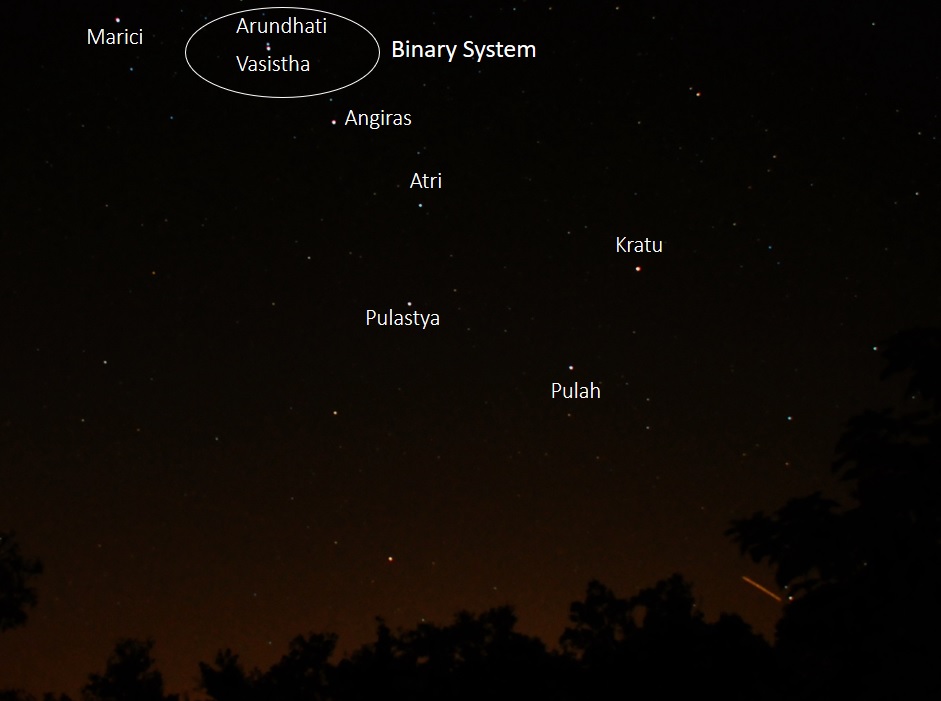
Figure 14: The Seven prominent stars of the Great Bear constellation symbolized the Seven Rsis. Vasistha – Arundhati forms a binary system. Adapted from: Wikimedia Commons / Henk Monster CC BY-SA 3.0. Link
Vasistha (Mizar) and Arundhati (Alcor) are a binary pair. In a binary system, two stars are “gravitationally bound” to each other and they orbit a common center of mass. The Vasistha (Mizar) – Arundhati (Alcor) binary system symbolized the “marital bond” in ancient India. A newly-wed bride was instructed to look at Arundhati (Alcor) and the Saptarsis (Great Bear) before requesting long-life for her husband, children and herself.40 The natural order was said to be disturbed when Arundhati (Alcor) eclipses Vasistha (Mizar)41, which happens very rarely since the orbital period of this binary is nearly 750,000 years. Evidently, Vedic astronomers knew about the Mizar-Alcor double thousands of years before Benedetto Castelli in the 16th century observed Mizar through a telescope and realized that it was a binary system.
So, it’s not only the Dogons who knew about binary star systems; the Vedic astronomers did too. It seems that advanced scientific knowledge was not uncommon in the ancient world!
The Ancient Interstellar Travelers
The different accounts of the Seven Sages indicate that they came to the earth from the stars. The Vedic legends associate them with the seven stars of the Great Bear, the Dogon say that they came from the Sirius, while the Aboriginal accounts suggest an origin in the stars of the Milky Way. This implies that the Seven Sages were extraterrestrial visitors to our planet. They probably came here with an objective to ensure that our planet serves as an effective “school” where souls can progress to higher states of consciousness. That is why, not only did they teach us all the sciences and skills of civilized life, but they also imparted to us a wealth of esoteric wisdom. Since our planet goes through repeated cycles of cataclysms, as we move from one Yuga to the next, they play a fundamental role in restarting our civilization after every major cataclysmic episode, and re-promulgate the sacred wisdom to the people of the new Age.
As we have discussed, the Sumerians believed that the Apkallu emerged from the waters of the apsu, which is supported by Aboriginal stories which tell us that the Wandjinas returned to the bottom of the watering holes, and the Dogon beliefs that the Nommo dug reservoirs of water and lived in a watery environment. This indicates that the Seven Sages, after arriving on our planet, fashioned a habitat for themselves in the freshwater aquifers below the earth, which could be accessed through tunnels and caverns hidden under mountains, lakes, rivers and seas. This subterranean world was probably designed to suit their “alien” physiology; a place of retreat, an underworld paradise, where they could live in peace, unaffected by the affairs of the noisy world above them. Subsequently, they produced many kinds of progenies with serpentine features who reside in these watery subterranean realms. As per the Vedic tradition, the Nagas are the progenies of the sage Marici through his son Kashyapa, while the Aboriginals believe that the Rainbow Serpent which lives in the watering holes and brings rainfall was created by the Wandjinas.
While the Seven Sages are believed to return back to their home planets (or stars) after their work of establishing civilization is completed, their Naga or Annunaki progenies, who were regarded by the ancients as their “Underworld Gods”, continue to live in the subterranean aquifers, and function as the protectors and benefactors of humanity. Since we are currently in the spiritually bankrupt Kali Yuga (Iron Age) – which is called the night of all creatures – the Nagas or Annunaki may be in a state of hibernation, waiting for the Kali Yuga to end, after which they may reveal themselves to humanity and pass on their wisdom to a new civilization.
Indeed, subterranean life may be the most common form of life on the other planets of the Solar System and beyond. Surface living – which comes with many attendant problems such as inclement weather, volcanic eruptions, asteroid bombardments, space radiation etc. – may be an exception, rather than the norm. In 2019, scientists found geological evidence of a “planet-wide groundwater system” on Mars.42 Pluto also has an underground ocean below its thick frozen shell, as does Europa, the fourth largest of Jupiter’s 67 confirmed moons, and Titan, the largest moon of Saturn. Astronomers believe that these subsurface oceans may act as incubators of life, being sheltered from extreme temperatures and high-energy radiation. Europa is a particularly interesting case, since water from its underground ocean bubbles up to the frozen surface. The exchange of chemicals and energy between the surface and the ocean increases the odds of oceanic life being present on Europa.43 “At least three million tons of fishlike creatures could theoretically live and breathe on Europa”, according to Richard Greenberg of the University of Arizona in Tucson.44
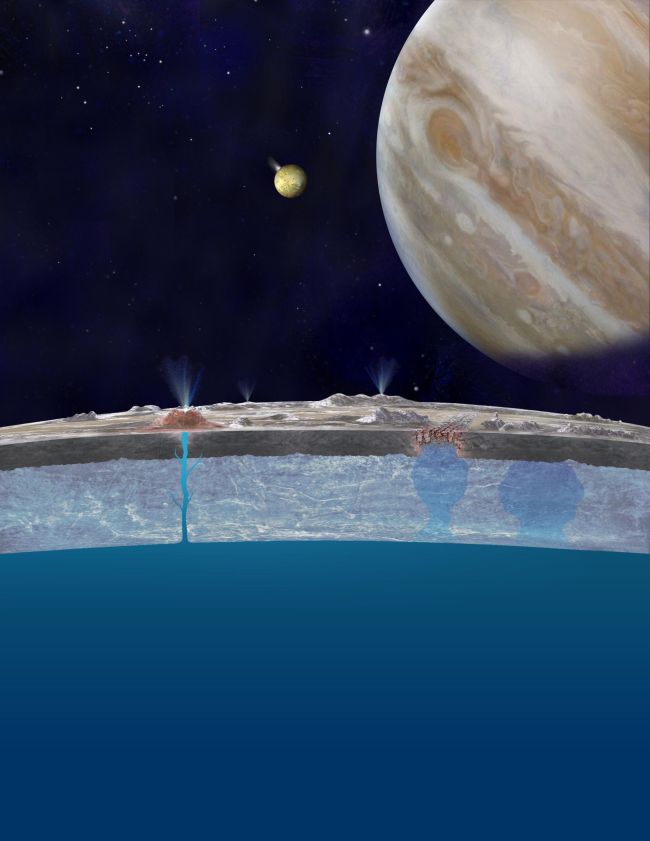
Figure 15: Water from the underground ocean of Europa bubbles up to the frozen surface through vents. Image Credit: NASA/JPL-Caltech, Public Domain. Link
If alien fishes may live in the underground oceans of other planets, then why not fish-men hybrids like the Apkallu? Or humanoid-serpent beings like the Nagas? Perhaps some of them even developed avian features such as feathers and wings? If alien life from the subterranean oceans of distant planetary systems master the art of interstellar travel and arrive on earth, where would they prefer to build their habitat? Most likely in an environment similar to their home planet or star, which in this case would be the subterranean freshwater aquifers of the earth. In other words, there could be a veritable alien world right below our feet, of which we know nothing about.
If the Seven Sages are extraterrestrial visitors, the question that naturally follows is, when and how did they get here. I think they probably came here hundreds of millions of years ago, to direct the course of evolution of life on earth. The Vedic texts describe them as the Prajapatis i.e. “Lords of Creation”, from whom all the creatures of the world came, while the Aboriginals claim that the Wandjinas created all the living beings on the earth. If I were to guess, I would say that the Seven Sages came to earth during the Cambrian Explosion nearly 540 million years ago when, in a space of just 10 million years, all the modern phylum of animal life made a first appearance in the fossil record. The anatomical range of this initial explosion exceeded that of modern life, as many early experiments died out and no new phyla have ever arisen.45 All animal evolution for the last half billion years has come from tinkering with these Cambrian body plans.46 Scientists are still puzzled by this stunning and unique flowering of animal life during this period, since prior to the Cambrian Explosion, for nearly 3 billion years, only unicellular life forms existed on earth.
Since the Cambrian explosion, our planet has gone through multiple mass extinction events which occur with a surprising periodicity of 26 million years, as well as innumerable Yuga Cycle transitions of lesser intensity. The traditions suggest that in every case the Seven Sages repopulated the earth with life forms after the cataclysmic episodes were over.
As to how the Seven Sages arrived here, there are a few possibilities. First, they could have manifested through dimensional gateways. In the Mahabharata, for instance, interdimensional travelers like the sage Narada – who, like the Saptarsis, is described as a “mind-born son of Brahma” – suddenly appear out of nowhere, which is suggestive of travel through dimensional gateways. The second option is to use spaceships or vimanas, which are mentioned in the Indian, Mesopotamian and the Hopi legends (in addition to others), although it is not clear if vimanas were designed solely for terrestrial travel and warfare, of if they could also be used for interstellar travel.
Finally, they could have hitched a ride on interstellar comets. Most scientists now believe that comets seeded life on earth by bringing in water and complex organic molecules. Modern proponents of Panspermia, such as astrophysicists Sir Fred Hoyle and Chandra Wickramasinghe, have proposed that comets brought the first living microorganisms to Earth, in the form of dormant bacteria, or desiccated DNA and RNA molecules. The unicellular life that thrived on earth for nearly 3 billion years before the Cambrian Explosion, was probably seeded by the heavy cometary bombardments that impacted the early earth.
Hoyle and Wickramasinghe have contended that life-bearing planetary ejecta can hitch a ride within the shielded environment of interstellar comets, and seed distant planetary systems with life – a theory known as cometary panspermia.47 Life on earth, therefore, may be of alien origin, a point that Wickramasinghe reiterated in a paper titled “The astrobiological case for our cosmic ancestry” (2010):
“Astronomy continues to reveal the presence of organic molecules and organic dust on a huge cosmic scale, amounting to a third of interstellar carbon tied up in this form. Just as the overwhelming bulk of organics on Earth stored over geological timescales are derived from the degradation of living cells, so it seems likely that interstellar organics in large measure also derive from biology. As we enter a new decade – the year 2010 – a clear pronouncement of our likely alien ancestry and of the existence of extraterrestrial life on a cosmic scale would seem to be overdue.”48
The cometary panspermia theory received a boost in 2017 when astronomers discovered the first interstellar space rock Oumuamua (1I/2017 U1), which crossed the Solar System in a hyperbolic orbit and accelerated away from the Sun like a comet. Oumuamua appeared to be a rocky, cigar-shaped object with a reddish hue, around 400 meters long, and 10 times as long as it is wide. That aspect ratio is greater than that of any asteroid or comet observed in our solar system to date. It was initially identified as a comet, but unlike a comet, Oumuamua showed no signs of a gaseous envelope or a tail. Instead, it’s high density and rapid spin on its axis was more consistent with an asteroid. Some astronomers even proposed that it could be an alien spacecraft! As of now, Oumuamua has been classified as an “interstellar rock”, but scientists continue to debate whether Oumuamua is a hydrogen comet whose outgassing of hydrogen was not visible from the earth or an alien spacecraft.
Wickramasinghe was quick to pounce on the significance of this discovery. With his colleagues, he authored a paper in which he wrote, that, “the theory that comets and cometary bodies are the means of transport for biology throughout the galaxy has been extensively discussed by Hoyle, Wickramasinghe and their many collaborators for over nearly 4 decades…the discovery of our first “visitor” on a hyperbolic orbit confirms our inextricable connection with life that may exist in distant planetary systems.”49
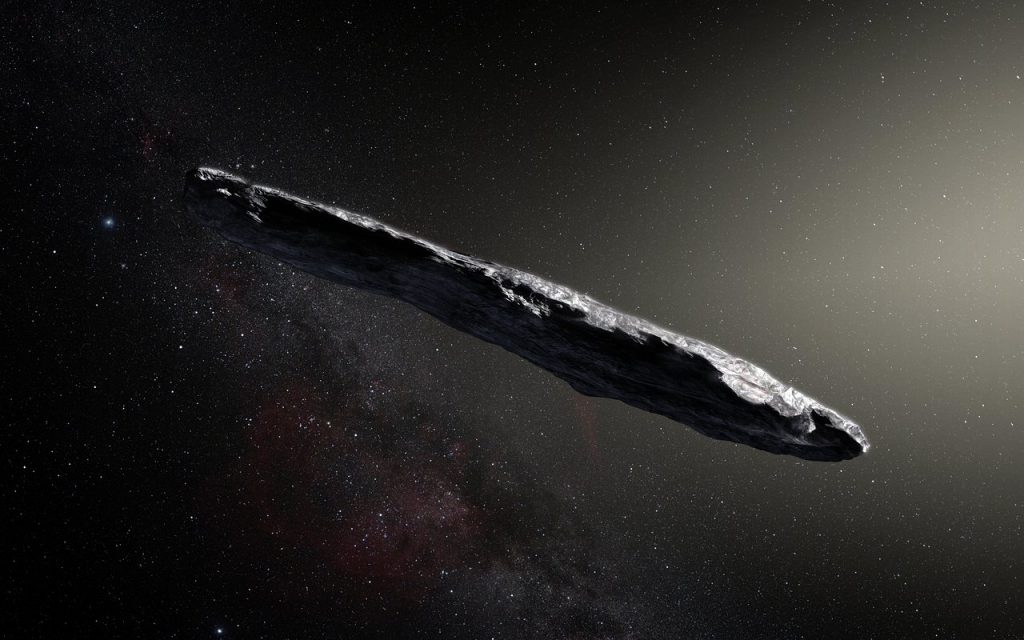
Figure 16: Artist’s impression of Oumuamua, the first detected interstellar object in our solar system. Source: ESO / M. Kornmesser, PD0
In 2019, astronomers discovered another Interstellar Comet named Borisov, which passed close to the Sun in December 2019, and, much to the surprise of astronomers, it suddenly brightened up as it left the Solar System in March 2020. It looks like the era of interstellar comets is here to stay, and a paradigm shift in our understanding of the universe is underway.
Conclusion
The tradition of the Seven Sages, along with the related iconography, was dispersed throughout the ancient world, which suggests that it must have been based on actual historical events of a remote past. The texts suggest that the Seven Sages were of extraterrestrial origin who had directed the evolution of life on earth and had created a habitat for themselves in the subterranean freshwater aquifers. These claims lie within the limits of plausibility, and there is no reason to dismiss them as myths and fantasies – as historians are so often inclined to do – without subjecting them to proper scientific scrutiny. As we become aware of our inextricable connections to life in the universe, it is time for us to let go of preconditioned modes of thinking and embrace new possibilities.
End Notes
1 Kvanvig, Helge (2011), Primeval History: Babylonian, Biblical, and Enochic: An Intertextual Reading, Brill, p 162
2 Berossus from Alexander Polyhistor recorded in Eusebius and Syncellus (translated from the Greek) taken from Cory 1828, pp. 24-38.
3 Lorena Laura Stookey, Thematic Guide to World Mythology (Greenwood Publishing Group, 2004) 80
4 Boye Lafayette De Mente, America’s Famous Hopi Indians!: Their Spiritual Way of Life & Incredible Prophecies!, Cultural-Insight Books (2010), p 18-35.
5 W. Buck Baker, Celtic Mythological Influences on American Theatre, 1750-1875 (University Press of America, 1994) 31
6 “Descent into the Underworld”, https://www.encyclopedia.com/environment/encyclopedias-almanacs-transcripts-and-maps/descent-underworld
7 The Vishnu Purana Book II Chapter V, translated by Horace Hayman Wilson, [1840], at sacred-texts.com, https://www.sacred-texts.com/hin/vp/vp063.htm
8 Robert Beer, The Encyclopedia of Tibetan Symbols and Motifs (Serindia Publications, 2004) 70-71.
9 Phan Anh Tu, “The Significance of Naga in Thai Architectural and Sculptural Ornaments” DIALOGUE, Volume-17 No. 4, http://qlkh.hcmussh.edu.vn/Resources/Docs/SubDomain/qlkh/20160815_PAT.pdf
10 Ibid
11 Reported from Arrian, Anabasis, VII. 26
12 Walter Mattfeld, http://www.bibleorigins.net/Serpentningishzida.html
13 Foster, Before the Muses 2nd edition, p. 483.
14 Mahabharata, Adi Parva: Sambhava Parva, Section CXXVIII, https://www.sacred-texts.com/hin/m01/m01129.htm
15 Hess, Richard S.; Tsumura, David Toshio, eds. (1994), “I studied inscriptions from before the flood”, Ancient Near Eastern, literary, and linguistic approaches to Genesis 1-11, Eisenbrauns, 4, ISBN978-0-931464-88-1
16 Kvanvig, Helge (2011), Primeval History: Babylonian, Biblical, and Enochic: An Intertextual Reading, Brill, p 160-163
17 Osama Shukir Muhammed Amin, “Wall Reliefs: Apkallus of the North-West Palace at Nimrud”, 19 September 2017, Ancient History Encyclopedia, https://www.ancient.eu/article/1122/wall-reliefs-apkallus-of-the-north-west-palace-at-/
18 Joseph Campbell, The Mythic Image, Princeton: Princeton University Press, 1974, p 116
19 Andrew Curry, “Gobekli Tepe: The World’s First Temple?”, Smithsonian Magazine, November 2008, https://www.smithsonianmag.com/history/gobekli-tepe-the-worlds-first-temple-83613665/
20 David Wroth, “Wandjina Dreamtime Story”, Japingka Aboriginal Art, July 2019, https://japingkaaboriginalart.com/articles/wandjina/
21 “Seven Sages”, Encyclopedia.com
22 For instance, Vaikhanesa Sutra, pravaraprasna v.8
23 Rig Veda 10.130.7, tr. Ralph Griffith
24 Rig Veda 9.92.2, tr. Ralph Griffith
25 Rig Veda 10.109.4, tr. Ralph Griffith
26 Rig Veda 10.130.6, tr. Ralph Griffith
27 Rig Veda 07.033.12 tr. Ralph Griffith
28 John E. Mitchiner, The Traditions of the Seven Rsis, Motilal Banarsidass Publ., 2000
29 The Bhagavad Gita 10.6-7, tr. Eknath Easwaran
30 Mahabharata 12.322.26-28
31 Mahabharata 12.322.36
32 Mahabharata 12.327.61-62
33 Mahabharata 12.327.65
34 Mahabharata 12.327.66
35 Harivamsa 12.13 -14
36 Matsya Purana 144.93-98
37 Brahmanda Purana 1.2.29.43-45, Vayu Purana 1.57.38-40
38 Matsya Purana 1.24.106
39 Vishnu Purana 3.2.44
40 Asvalayana Grhya Sutra 1.7.22
41 Mahabharata 6.2.31
42 Jackson Ryan, “Scientists find first evidence of huge Mars underground water system”, CNET Feb. 28, 2019, https://www.cnet.com/news/mars-orbiter-scientists-find-first-evidence-of-huge-mars-underground-water-system/
43 Mike Wall, “On Jupiter’s Moon Europa, Underground Ocean Bubbles Up to Surface” Space.com March 06, 2013, https://www.space.com/20078-jupiter-moon-europa-ocean-surface.html
44 Victoria Jaggard, “Could Jupiter Moon Harbor Fish-Size Life?”, National Geographic, November 16, 2009, https://www.nationalgeographic.com/science/2009/11/jupiter-moon-europa-life/
45 Stephen Jay Gould, The Evolution Of Life On Earth, SCIENTIFIC AMERICAN, October, 1994.
46 The Cambrian Explosion, PBS.org, https://www.pbs.org/wgbh/evolution/library/03/4/l_034_02.html
47 Wickramasinghe, C. (2011). Bacterial morphologies supporting cometary panspermia: A reappraisal. International Journal of Astrobiology, 10(1), 25-30. doi:10.1017/S1473550410000157
48 Wickramasinghe, C. (2010). The astrobiological case for our cosmic ancestry. International Journal of Astrobiology, 9(2), 119-129. doi:10.1017/S1473550409990413
49 N. Chandra Wickramasinghe, Edward J. Steele, Daryl. H. Wallis, Robert Temple, Gensuke Tokoro, Janaki T. Wickramasinghe, “Oumuamua (A/2017U1) – A Confirmation of Links between Galactic Planetary Systems”, Advances in Astrophysics, Vol. 3, No. 1, February 2018 https://dx.doi.org/10.22606/adap.2018.31003






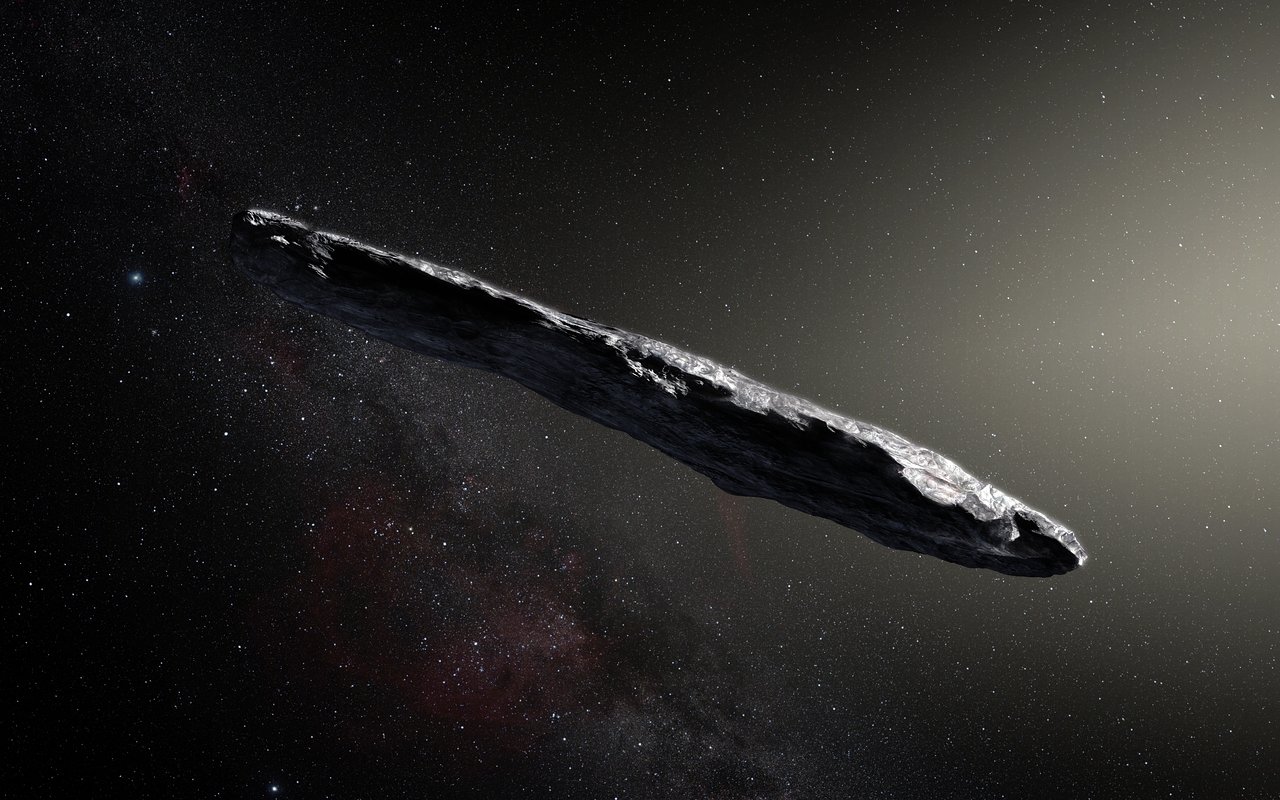

Great stuff thanks! In the news:
https://www.sciencealert.com/multiple-underground-lakes-of-liquid-water-have-been-found-on-mars
Have you ever thought of this option. A former human
https://norwegianscitechnews.com/2017/07/human-evolution-in-the-sea-at-bioko/
https://www.the-scientist.com/reading-frames/did-human-evolution-include-a-semi-aquatic-phase–67306
https://phys.org/news/2018-04-genetic-humans.html
Like Graham Hancock has said in fingerprints of the gods, it could be all just a former advanced humanoid earth based creature that evolved before us and not from the stars at all, But the extreme UFOLOGY community would like to believe in there beliefs.
Also Robert S has reported people went subterranean after the sun sent plasma storms to the earth and we thought it was the war of the gods in the sky, and the Younger Dryas event but being ignorant of natures events we anthropomorphise these natural events into Godly events. Thor, INdra etc etc
Also these bird men are represented by many shaman cultures around the world and get alot from taking hallucinations. Soma juice, burning bush incident etc etc
It would only seem that the hindhus and dogon say they come from the stars. While Sumerians Akkadians etc say they came from the water. So there are conflicting views already to where they came from, from different cultures.
There may be an even simpler explanation. The two anthropologists who first studied the Dogon (Griaule and Deiterlen) conducted their research in the 1930s. Sirius B was known to exist then. In their original findings, Griaule and Deiterlen make no comment about the Dogon knowledge of Sirius B. This is strange, because one would think that it would be a major discovery in anthropology.
Also it has been found that ancient Egypt Had contact with the Dogon Tribe etc…https://www.skeptic.com/eskeptic/10-01-13/
Still more questions than answers.
Im not stastified yet but keep open mind.
Wandjina are the supreme spirit ancestors of the Indigenous people of the Kimberley. Other Australian aboriginals do not have the Wandjina.
The water spirit Nommo is
not a central figure in Dogon thought and has none of
the characteristics of a creator or a redeemer.
please do more analytical study, Is Sirius a double star? The ethnographic facts are
quite straightforward. The Dogon, of course, know Sirius as a star (it is after all the brightest in the sky),
calling it dana tolo, the hunter’s star (the game and the
dogs are represented by Orion’s belt). Knowledge of the
stars is not important either in daily life or in ritual.
The position of the sun and the phases of the moon are
more pertinent for Dogon reckoning. No Dogon outside
the circle of Griaule’s informants had ever heard of sigu
tolo or p6 tolo, nor had any Dogon even heard of erne
ya tolo (according to Griaule in RP Dogon names for
150 I CURRENT ANTHROPOLOGY Volume 32, Number 2, April 1991
Sirius and its star companions). Most important, no one,
even within the circle of Griaule informants, had ever
heard or understood that Sirius was a double star (or,
according to RP, even a triple one, with B and C orbiting
A). Consequently, the purported knowledge of the mass
of Sirius B or the orbiting time was absent. The scheduling of the sigu ritual is done in several ways in Yugo
Doguru, none of which has to do with the stars.1°
http://home.iscte-iul.pt/~fgvs/VanBeek,Dogon.pdf
some people can use there imagination and create something out of nothing.
Even Robert Temple said…
And yet this is just the conclusion that Temple does not draw. More than that: he dismisses it. ‘It is more satisfactory,’ he writes, ‘not to have to presume the preposterous notion that intelligent beings from outer space landed in Africa, imparted specific information to a West African tribe, then returned to space and left the rest of the world alone. Such a theory never really struck me as possible.’
Instead, he gives over a large section of his book to tracing ‘Sirian’ themes in the ancient beliefs of the Greeks, Sumerians, and above all Egyptians.
As Carl Sagan commented in his book, Broca’s Brain, the conclusion about planetary orbits, though a rare insight, is one that can be achieved without high technology, as demonstrated by some Greeks and Copernicus. As for the moons of Jupiter, and Saturn’s ring, with a combination of extraordinary eyesight and perfectly clear skies, it just might be possible to see them without a telescope.
In 1991 Walter van Beek, a Belgian anthropologist, led a team of anthropologists to study the Dogon tribe. Although he hoped to find evidence for their astounding astronomical knowledge, the team found no trace of the detailed Sirius lore reported by Griaule.
In 1991 Walter van Beek, a Belgian anthropologist, led a team of anthropologists to study the Dogon tribe. Although he hoped to find evidence for their astounding astronomical knowledge, the team found no trace of the detailed Sirius lore reported by Griaule.
https://chandra.harvard.edu/chronicle/0400/sirius_part2.html
Regarding the Vedic Vimanas it all depends on the translations which can make things look totally different….The word Vimana literally means ‘having been measured out’[3]. It was related to the king’s palaces, and was referring to their intricate construction. Later on, as a result the word became synonymous with palaces in general. And because of that it was used to refer to the palaces of the gods as well[4].
And yes these palaces of the gods were in the heavens, and they could fly, but as we look into this it will be clear that some of the Vimanas of the gods really were huge palaces, with gardens and terraces and golden staircases.
In the early 1900s, Pandit Subbaraya Shastry dictated the text of Vaimānika
The Vimanika Shastra is not an actual ancient text. It was channeled, or dictated, to the author from the spirit world in 1918[5].
The spirit who supposedly dictated the text claimed to be and ancient seer named Bharadvada, who is prominent in some ancient writings[6], so I guess that is what is supposed to give this text credibility – that is, the idea that the ghost of someone ancient supposedly dictated it.
https://www.ancientaliensdebunked.com/vimanas
Who is doing the translations in the first place. just like Zacheria stichens works they are made up of biased opinions.
First lets here is Childress’ version:
“When morning dawned, Rama, taking the Celestial Car Puspaka had sent to him by Vivpishand, stood ready to depart. Self-propelled was that car. It was large and finely painted. It had two stories and many chambers with windows, and was draped with flags and banners. It gave forth a melodious sound as it coursed along its airy way.”
And now here is what the actual Ramayana says:
“And the mighty monkey ascended the splendid car Pushpaka, containing figures of wolves,—made of Kart taswara and Hir anya; graced with ranges of goodly pillars; as if blazing in splendor; throughout garnished with narrow secret rooms and saloons, piercing the heavens, and resembling Meru or Mandara, and like unto the flaming Sun; skillfully reared by Vic wak arma; with golden staircases and graceful and grand raised seats, rows of golden and crystal windows, and daises composed of sapphires, emeralds and other superb gems; embellished with noble vid-rumas, costly stones, and round pearls, as also with plastered terraces; pasted with red sandal, like unto gold, and furnished with a sacred aroma; and resembling the sun new risen[12]. (Sundarakandam 9)”
Another view on the Handbags…https://www.ancient-origins.net/artifacts-other-artifacts/what-mysterious-handbag-seen-ancient-carvings-across-cultures-and-021191
and again another view on the Megalithic stones of GobeKLI TEPE ,ITs all based on natural events and humans anthropomorphise natures energies from lack of understanding how nature worked.
A team of researchers with the University of Edinburgh has found what they describe as evidence of a comet striking the Earth at approximately the same time as the onset of the Younger Dryas in carvings on an ancient stone pillar in southern Turkey. The group has published their findings in the journal Mediterranean Archaeology and Archaeometry.
https://phys.org/news/2017-04-ancient-stone-pillars-clues-comet.html
The original Atlantis story? The 7 sages – Survivors.
Surviving the watery cataclysm would explain the fish like characteristics given to them as they emerged from the disaster, and then those survivors setting out to reboot humanity across the world – with advanced technology that seemed like magic to those with no memory or knowledge.
my head is reeling . excellent article. moore to probe i believe. hats off to you !
DR K.SRINIVASAN Ph.D
INDIA